Unit 4 Then and now 单元复习(三)-语法+典型例题(共43张PPT)
文档属性
| 名称 | Unit 4 Then and now 单元复习(三)-语法+典型例题(共43张PPT) |  | |
| 格式 | pptx | ||
| 文件大小 | 19.3MB | ||
| 资源类型 | 试卷 | ||
| 版本资源 | 人教版(PEP) | ||
| 科目 | 英语 | ||
| 更新时间 | 2025-03-11 15:43:03 | ||
图片预览

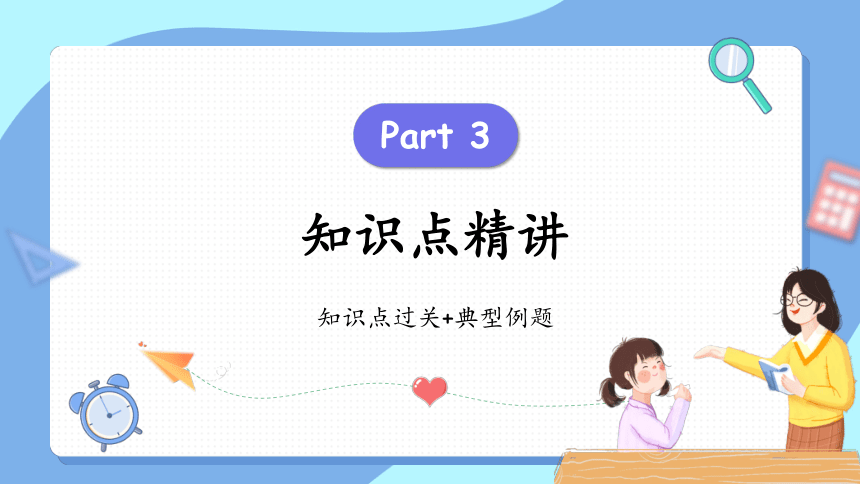
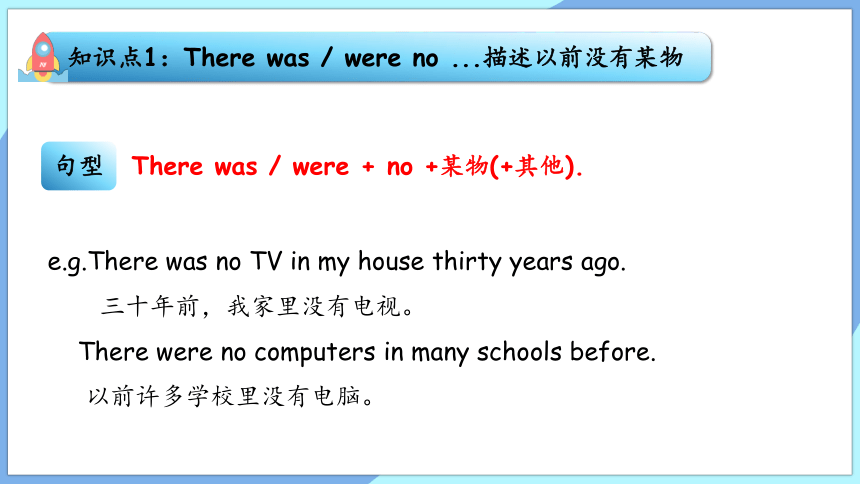


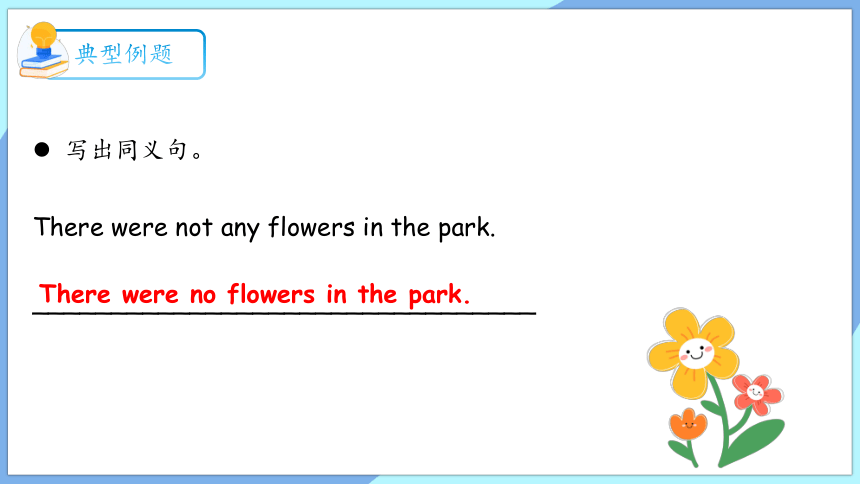
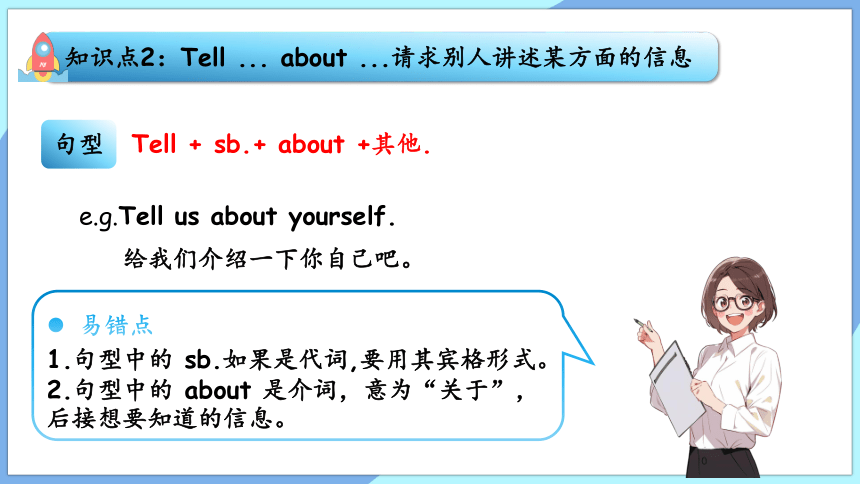
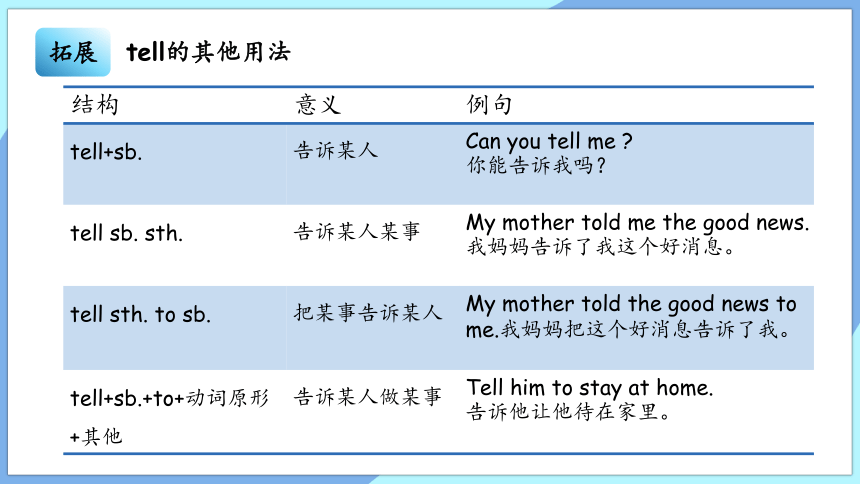
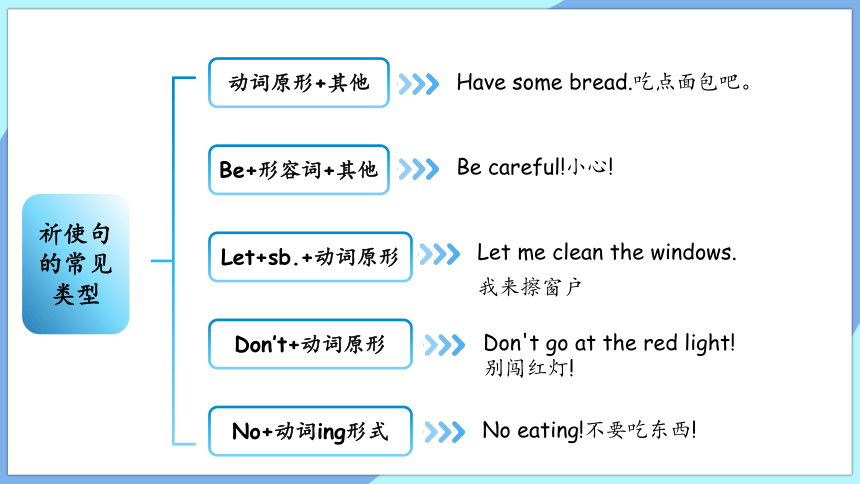

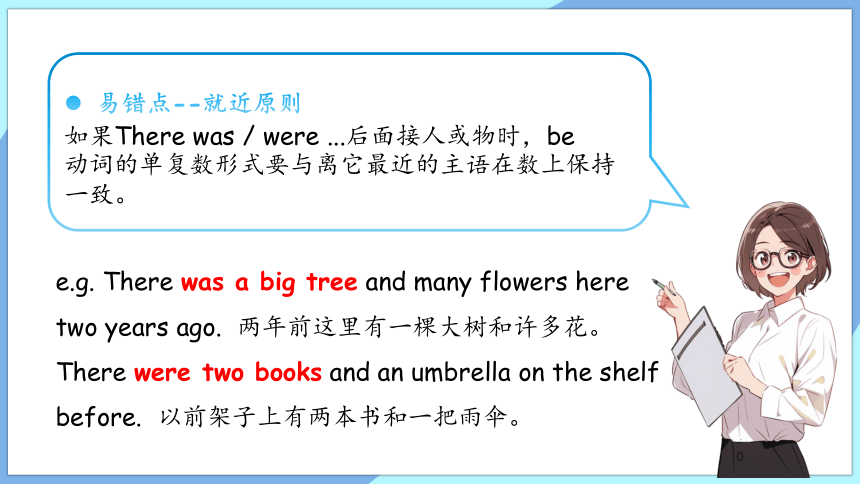
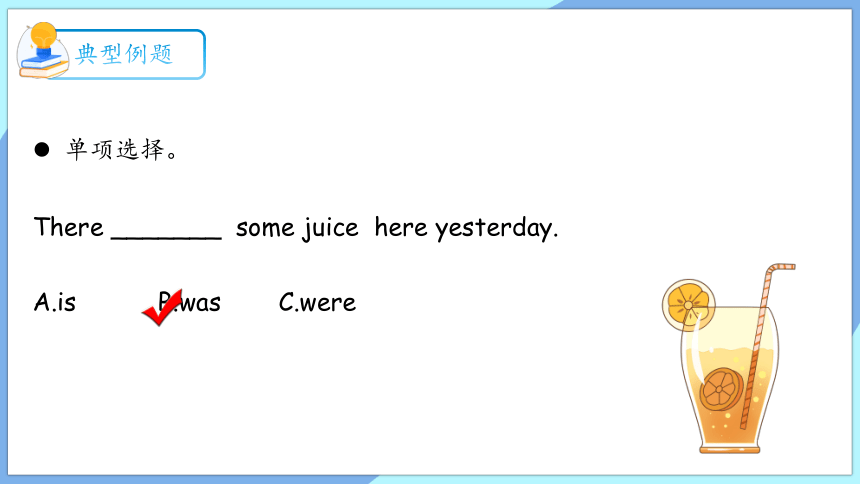
文档简介
(共43张PPT)
Unit 4
人教六下复习课件
主讲教师:Cici
时间:2024.4.17
知识点精讲
知识点过关+典型例题
Part 3
知识点1:There was / were no ...描述以前没有某物
句型
There was / were + no +某物(+其他).
e.g.There was no TV in my house thirty years ago.
三十年前,我家里没有电视。
There were no computers in many schools before.
以前许多学校里没有电脑。
知识点1:There was / were no ...描述以前没有某物
易错点
1.句型中的“no”表示否定,相当于“not (a/
an)”,意为“没有”,后面要接名词。
2.当某物为可数名词单数或不可数名词时,用 was;当某物为可数名词复数时,用 were。
知识点1:There was / were no ...描述以前没有某物
温故知新
There is / are not ...描述没有某人或某物.
句型:There is /are not +某人/物(+其他).
e.g.There aren't many people.没有很多人。
(五年级上册 Unit 6)
典型例题
写出同义句。
There were not any flowers in the park.
________________________________
There were no flowers in the park.
知识点2:Tell ... about ...请求别人讲述某方面的信息
句型
Tell + sb.+ about +其他.
e.g.Tell us about yourself.
给我们介绍一下你自己吧。
易错点
1.句型中的 sb.如果是代词,要用其宾格形式。
2.句型中的 about 是介词,意为“关于”,后接想要知道的信息。
拓展
tell的其他用法
结构 意义 例句
tell+sb. 告诉某人 Can you tell me
你能告诉我吗?
tell sb. sth. 告诉某人某事 My mother told me the good news.
我妈妈告诉了我这个好消息。
tell sth. to sb. 把某事告诉某人 My mother told the good news to me.我妈妈把这个好消息告诉了我。
tell+sb.+to+动词原形+其他 告诉某人做某事 Tell him to stay at home.
告诉他让他待在家里。
祈使句
的常见类型
动词原形+其他
Be+形容词+其他
Let+sb.+动词原形
Don’t+动词原形
No+动词ing形式
Have some bread.吃点面包吧。
Be careful!小心!
Let me clean the windows.
我来擦窗户
Don't go at the red light!
别闯红灯!
No eating!不要吃东西!
知识点3:There was / were ...描述过去有……
句型
There was / were +某人/某物(+其他).
e.g. There was a big tree in front of my house before.
以前我家门前有棵大树。
There were a lot of fish in the river before.以前这条河里有许多鱼。
用法
用于表达过去某处有某人或某物。
如果某物为可数名词单数或不可数名词,be动词用was;
当某物为可数名词复数时,be 动词用 were。
易错点--就近原则
如果There was / were ...后面接人或物时,be
动词的单复数形式要与离它最近的主语在数上保持一致。
e.g. There was a big tree and many flowers here two years ago. 两年前这里有一棵大树和许多花。
There were two books and an umbrella on the shelf before. 以前架子上有两本书和一把雨伞。
典型例题
单项选择。
There _______ some juice here yesterday.
A.is B.was C.were
知识点4: one day 的用法
用法1
one day 在此句中意为“有一天”,表示将来某个不确定的时间。
e.g. He wants to be a teacher one day.
他想有朝一日成为一位老师。
用法2
one day也可表示过去某时间,意为“有一天”。
e.g. One day he came to the little village.
有一天他来到了这个小村庄。
典型例题
单项选择。
Mary is going to be a police officer __________
A. last year B. now C. one day
知识点5: take 表示“需要……时间”
用法
“took”是“take”的过去式,后面通常接表示时间的名词(短语)作宾语。
e.g. It took me four hours to clean my room.
打扫我的房间花了我四个小时的时间。
典型例题
单项选择。
It ________ me three hours to make this cake.
A. looked B. took C. take
知识点6: about 的用法
about
大约
关于
There are about sixty books in this room.
在这个房间里大约有60本书。
I want to buy a book about football.
我想买一本关于足球的书。
知识点7:How do / does sb. know ... 询问某人如何得知某事
句型
How +助动词+ sb. + know +其他
e.g. How does Mike know that
迈克是怎么知道的
用法
助动词的形式由sb.决定,know 后面接宾语,表示知道的内容。
典型例题
情景选择。
张鹏告诉吴斌斌,沙滩运动会将推迟举办。吴斌斌想知道张鹏是怎么知道这一消息的,他问:___________________
A. How do you know that
B. Why do you know that
C. When do you know that
知识点8:look up 的用法
用法
look up 意为(在词典中或通过电脑)查阅。
look up
look up+名词
look+名词+up
look +代词+up
I looked up these wordsin the dictionary.
我在词典中查阅的这些单词。
You can look it up on the Internet.
你可以在网上查一查。
典型例题
单项选择。
Please look up________on the Internet.
A.it B. the news C.them
典型例题
判断下列句子对(T)错(F)。
( ) ①Let's look it up in the dictionary.
( )②He looked the story up on the Internet.
( )③He looked up the story on the Internet.
T
T
T
知识点9:There was / were no A or B.描述以前既没有A也没有B
句型
There was / were + no +A+ or +B (+其他),
e.g. Before there was no computer or car in my house.
以前我家没有电脑也没有汽车。
用法
or在此句型中为连词,意思是“也不”。用于否定句中连接并列成分,相当于肯定句中的“and”。
易错点
肯定句中并列连词应用and,在把含有and 的
肯定句改为否定句时,要把连词and 改为 or。
e.g. The students sang and danced in the park yesterday.
昨天学生们在公园里唱歌跳舞了。
The students didn't sing or dance in the park yesterday.
昨天学生们在公园里没有唱歌也没有跳舞。
典型例题
选一选。
There were no buses ______ cars in my village before.
A. and B.or C.but
② There _______ no camera in my family at that time.
A. is B. were C.was
知识点10:表示过去时间的词
There was no gym in my school twenty years ago.
二十年前我的学校里没有体育馆。
解析
本句是一般过去时。一般过去时表示在过去某个特定时间发生的动作或存在的状态,也表示过去经常或反复发生的动作,常与表示过去时间的单词或短语连用。“twenty years ago”就是一个表示过去时间的短语,意为“二十年前”。
重点
表示过去的时间状语
构成 例词 例句
yesterday+ 一天中的某个时间 yesterday morning 昨天上午 yesterday afternoon 昨天下午 yesterday evening 昨天晚上 Where did you goyesterday
昨天你去哪儿了?
I went swimming yesterday morning.
昨天上午我去游泳了。
last+表示时间的名词 last week 上周 last year 去年 last month 上个月 last night 昨晚 We didn’t have classes last week.
上周我们没有课。
构成 例词 例句
表示时间的名词或短语+ago 以前... three years ago三年前 two months ago两个月以前 three weeks ago三周以前 He came here three years ago.他三年前来到这里。
介词+过去的年、月、日 in 1936在1936年 on May 1,1976 在1976年5月1日 I met him in 1994.
我在1994 年遇见了他。
the day + before ... ...的前一天 the day before yesterday 前天 I washed my clothes the day before yesterday.前天我洗我的衣服了。
典型例题
单项选择
①There was no bus here__________ .
A. tomorrow B. yesterday C.morning
②I want to buy some fruit__________ .
A. today B. yesterday afternoon C. the day before yesterday
③ There were some flowers in the park __________ .
A.now B. last year C. next year
典型例题
单项选择
④ Did you know this thing two years________
A.now B. last C. ago
⑤He worked in that factory________.
A.in 2047 B.in 2023 C. on June 2nd, 2035
典型例题
单项选择
⑥We________camping last weekend.
A.go B.goes C. went
⑦They________ horses three years ago.
A. ride B. riding C. rode
知识点11:Before ... Now ...描述某人或某物过去到现在的状态变化
句型
Before,主语+was / were +形容词.Now,主语+ am / is / are +形容词(+其他).
用法
在英语中,描述某人或某物不同时期的情况要使用不同的时态。如果描述过去的情况,要使用一般过去时;如果描述现在的情况,要使用一般现在时。
e.g. Before, I was short. Now, I am very tall.
以前我个子矮。现在我很高。
易错点
1.before 是一个表示过去时间的副词,意为“以前”,与一般过去时连用,用于描述过去的情况。当主语是第三人称单数或I时,be动词用was,其他情况用were。
2.now 意为“现在”,与一般现在时连用,用于描述现在的状况。当主语是第一人称单数时,be动词用am;当主语是第三人称单数时,be动词用 is;其他情况用 are。
重点
如何描述人们的行为、能力的变化
类别 句型结构 例句
描述 行为 变化 Before,主语+动词过去式+其他.Now,主语+动词原形/动词的第三人称单数形式+其他. Before, he didn't like white. Now, he likes white.
以前他不喜欢自色。现在他喜欢白色。
描述 能力 变化 Before, 主语+couldn't+动词原形+其他. Now,主语+动词原形/动词的第三人称单数形式 +其他. Before, he couldn't speak English. Now, he speaks English well.
以前他不会说英语。现在他英语说得很好。
典型例题
单项选择
① Before, he__very fat. Now, he___thin.
A.is; is B.was; was C.was; is
② Before, her hair was long.______her hair is short.
A. But B.And C. Now
③ Before, he___eggs.Now, he___eggs every day,
A. didn't eat; eats B. don't eat; is eating C. doesn't eat; eat
知识点12:定语从句
解析
这是个含有定语从句的句子,句中的“he could do”修饰限定 nothing,是定语从句。当句中的名词或代词由一个句子来修饰,该句子就是定语从句。
There was nothing he could do.
他什么都做不了。
知识点12:定语从句
用法
定语从句要放在被修饰的名词或代词后面。
e.g. The girl who has long hair is my sister.
有长头发的那个女孩是我妹妹。
典型例题
连词成句。
there, nothing, was, I, see, could(.)
________________________________
There was nothing I could see.
知识点13:wake up 醒来
用法
wake up的过去式:woke up
wake up 与get up 的区别 wake up 醒来, 指人还在床上没站起身来 He woke up early, but did not get up.
他很早就醒了,但没起床。
get up “起床”, 表示穿衣起床的动作。 He woke up at6:00 and got up at 6:30 yesterday.
他昨天六点醒来,六点半起床。
知识点14:There will be ...表示某处将来有某物
句型
There will be + 主语(+其他).
e.g. In 2050, there will be house robots.
在2050年,将会有家用机器人。
用法
该句型中 be 动词不随主语的单复数而发生变化,
只能用 be动词原形。
重点
there will be 的句式变化
分类 句型 例句
肯定句 There will be +主语(+其他). There will be lots of buildings in our town next year.
明年我们镇里将会有很多楼房。
否定句 There won't (will not) be +主语 (+其他). There won't be lots of buildings in our town next year.
明年我们镇里将不会有很多楼房。
一般疑问句 --Will there be +主语(+其他) --Yes, there will. /No, there won't. --Will there be lots of buildings in our town next year
明年我们镇里将会有很多楼房吗
--Yes, there will./ No, there won't.是的,会有。/不,不会有。
典型例题
看图,用be动词的适当形式填空(每空一词)。
①In my new school, there________(be) a library.
②In my school there________(be) a library next year
was
will be
Unit 4
人教六下复习课件
Unit 4
人教六下复习课件
主讲教师:Cici
时间:2024.4.17
知识点精讲
知识点过关+典型例题
Part 3
知识点1:There was / were no ...描述以前没有某物
句型
There was / were + no +某物(+其他).
e.g.There was no TV in my house thirty years ago.
三十年前,我家里没有电视。
There were no computers in many schools before.
以前许多学校里没有电脑。
知识点1:There was / were no ...描述以前没有某物
易错点
1.句型中的“no”表示否定,相当于“not (a/
an)”,意为“没有”,后面要接名词。
2.当某物为可数名词单数或不可数名词时,用 was;当某物为可数名词复数时,用 were。
知识点1:There was / were no ...描述以前没有某物
温故知新
There is / are not ...描述没有某人或某物.
句型:There is /are not +某人/物(+其他).
e.g.There aren't many people.没有很多人。
(五年级上册 Unit 6)
典型例题
写出同义句。
There were not any flowers in the park.
________________________________
There were no flowers in the park.
知识点2:Tell ... about ...请求别人讲述某方面的信息
句型
Tell + sb.+ about +其他.
e.g.Tell us about yourself.
给我们介绍一下你自己吧。
易错点
1.句型中的 sb.如果是代词,要用其宾格形式。
2.句型中的 about 是介词,意为“关于”,后接想要知道的信息。
拓展
tell的其他用法
结构 意义 例句
tell+sb. 告诉某人 Can you tell me
你能告诉我吗?
tell sb. sth. 告诉某人某事 My mother told me the good news.
我妈妈告诉了我这个好消息。
tell sth. to sb. 把某事告诉某人 My mother told the good news to me.我妈妈把这个好消息告诉了我。
tell+sb.+to+动词原形+其他 告诉某人做某事 Tell him to stay at home.
告诉他让他待在家里。
祈使句
的常见类型
动词原形+其他
Be+形容词+其他
Let+sb.+动词原形
Don’t+动词原形
No+动词ing形式
Have some bread.吃点面包吧。
Be careful!小心!
Let me clean the windows.
我来擦窗户
Don't go at the red light!
别闯红灯!
No eating!不要吃东西!
知识点3:There was / were ...描述过去有……
句型
There was / were +某人/某物(+其他).
e.g. There was a big tree in front of my house before.
以前我家门前有棵大树。
There were a lot of fish in the river before.以前这条河里有许多鱼。
用法
用于表达过去某处有某人或某物。
如果某物为可数名词单数或不可数名词,be动词用was;
当某物为可数名词复数时,be 动词用 were。
易错点--就近原则
如果There was / were ...后面接人或物时,be
动词的单复数形式要与离它最近的主语在数上保持一致。
e.g. There was a big tree and many flowers here two years ago. 两年前这里有一棵大树和许多花。
There were two books and an umbrella on the shelf before. 以前架子上有两本书和一把雨伞。
典型例题
单项选择。
There _______ some juice here yesterday.
A.is B.was C.were
知识点4: one day 的用法
用法1
one day 在此句中意为“有一天”,表示将来某个不确定的时间。
e.g. He wants to be a teacher one day.
他想有朝一日成为一位老师。
用法2
one day也可表示过去某时间,意为“有一天”。
e.g. One day he came to the little village.
有一天他来到了这个小村庄。
典型例题
单项选择。
Mary is going to be a police officer __________
A. last year B. now C. one day
知识点5: take 表示“需要……时间”
用法
“took”是“take”的过去式,后面通常接表示时间的名词(短语)作宾语。
e.g. It took me four hours to clean my room.
打扫我的房间花了我四个小时的时间。
典型例题
单项选择。
It ________ me three hours to make this cake.
A. looked B. took C. take
知识点6: about 的用法
about
大约
关于
There are about sixty books in this room.
在这个房间里大约有60本书。
I want to buy a book about football.
我想买一本关于足球的书。
知识点7:How do / does sb. know ... 询问某人如何得知某事
句型
How +助动词+ sb. + know +其他
e.g. How does Mike know that
迈克是怎么知道的
用法
助动词的形式由sb.决定,know 后面接宾语,表示知道的内容。
典型例题
情景选择。
张鹏告诉吴斌斌,沙滩运动会将推迟举办。吴斌斌想知道张鹏是怎么知道这一消息的,他问:___________________
A. How do you know that
B. Why do you know that
C. When do you know that
知识点8:look up 的用法
用法
look up 意为(在词典中或通过电脑)查阅。
look up
look up+名词
look+名词+up
look +代词+up
I looked up these wordsin the dictionary.
我在词典中查阅的这些单词。
You can look it up on the Internet.
你可以在网上查一查。
典型例题
单项选择。
Please look up________on the Internet.
A.it B. the news C.them
典型例题
判断下列句子对(T)错(F)。
( ) ①Let's look it up in the dictionary.
( )②He looked the story up on the Internet.
( )③He looked up the story on the Internet.
T
T
T
知识点9:There was / were no A or B.描述以前既没有A也没有B
句型
There was / were + no +A+ or +B (+其他),
e.g. Before there was no computer or car in my house.
以前我家没有电脑也没有汽车。
用法
or在此句型中为连词,意思是“也不”。用于否定句中连接并列成分,相当于肯定句中的“and”。
易错点
肯定句中并列连词应用and,在把含有and 的
肯定句改为否定句时,要把连词and 改为 or。
e.g. The students sang and danced in the park yesterday.
昨天学生们在公园里唱歌跳舞了。
The students didn't sing or dance in the park yesterday.
昨天学生们在公园里没有唱歌也没有跳舞。
典型例题
选一选。
There were no buses ______ cars in my village before.
A. and B.or C.but
② There _______ no camera in my family at that time.
A. is B. were C.was
知识点10:表示过去时间的词
There was no gym in my school twenty years ago.
二十年前我的学校里没有体育馆。
解析
本句是一般过去时。一般过去时表示在过去某个特定时间发生的动作或存在的状态,也表示过去经常或反复发生的动作,常与表示过去时间的单词或短语连用。“twenty years ago”就是一个表示过去时间的短语,意为“二十年前”。
重点
表示过去的时间状语
构成 例词 例句
yesterday+ 一天中的某个时间 yesterday morning 昨天上午 yesterday afternoon 昨天下午 yesterday evening 昨天晚上 Where did you goyesterday
昨天你去哪儿了?
I went swimming yesterday morning.
昨天上午我去游泳了。
last+表示时间的名词 last week 上周 last year 去年 last month 上个月 last night 昨晚 We didn’t have classes last week.
上周我们没有课。
构成 例词 例句
表示时间的名词或短语+ago 以前... three years ago三年前 two months ago两个月以前 three weeks ago三周以前 He came here three years ago.他三年前来到这里。
介词+过去的年、月、日 in 1936在1936年 on May 1,1976 在1976年5月1日 I met him in 1994.
我在1994 年遇见了他。
the day + before ... ...的前一天 the day before yesterday 前天 I washed my clothes the day before yesterday.前天我洗我的衣服了。
典型例题
单项选择
①There was no bus here__________ .
A. tomorrow B. yesterday C.morning
②I want to buy some fruit__________ .
A. today B. yesterday afternoon C. the day before yesterday
③ There were some flowers in the park __________ .
A.now B. last year C. next year
典型例题
单项选择
④ Did you know this thing two years________
A.now B. last C. ago
⑤He worked in that factory________.
A.in 2047 B.in 2023 C. on June 2nd, 2035
典型例题
单项选择
⑥We________camping last weekend.
A.go B.goes C. went
⑦They________ horses three years ago.
A. ride B. riding C. rode
知识点11:Before ... Now ...描述某人或某物过去到现在的状态变化
句型
Before,主语+was / were +形容词.Now,主语+ am / is / are +形容词(+其他).
用法
在英语中,描述某人或某物不同时期的情况要使用不同的时态。如果描述过去的情况,要使用一般过去时;如果描述现在的情况,要使用一般现在时。
e.g. Before, I was short. Now, I am very tall.
以前我个子矮。现在我很高。
易错点
1.before 是一个表示过去时间的副词,意为“以前”,与一般过去时连用,用于描述过去的情况。当主语是第三人称单数或I时,be动词用was,其他情况用were。
2.now 意为“现在”,与一般现在时连用,用于描述现在的状况。当主语是第一人称单数时,be动词用am;当主语是第三人称单数时,be动词用 is;其他情况用 are。
重点
如何描述人们的行为、能力的变化
类别 句型结构 例句
描述 行为 变化 Before,主语+动词过去式+其他.Now,主语+动词原形/动词的第三人称单数形式+其他. Before, he didn't like white. Now, he likes white.
以前他不喜欢自色。现在他喜欢白色。
描述 能力 变化 Before, 主语+couldn't+动词原形+其他. Now,主语+动词原形/动词的第三人称单数形式 +其他. Before, he couldn't speak English. Now, he speaks English well.
以前他不会说英语。现在他英语说得很好。
典型例题
单项选择
① Before, he__very fat. Now, he___thin.
A.is; is B.was; was C.was; is
② Before, her hair was long.______her hair is short.
A. But B.And C. Now
③ Before, he___eggs.Now, he___eggs every day,
A. didn't eat; eats B. don't eat; is eating C. doesn't eat; eat
知识点12:定语从句
解析
这是个含有定语从句的句子,句中的“he could do”修饰限定 nothing,是定语从句。当句中的名词或代词由一个句子来修饰,该句子就是定语从句。
There was nothing he could do.
他什么都做不了。
知识点12:定语从句
用法
定语从句要放在被修饰的名词或代词后面。
e.g. The girl who has long hair is my sister.
有长头发的那个女孩是我妹妹。
典型例题
连词成句。
there, nothing, was, I, see, could(.)
________________________________
There was nothing I could see.
知识点13:wake up 醒来
用法
wake up的过去式:woke up
wake up 与get up 的区别 wake up 醒来, 指人还在床上没站起身来 He woke up early, but did not get up.
他很早就醒了,但没起床。
get up “起床”, 表示穿衣起床的动作。 He woke up at6:00 and got up at 6:30 yesterday.
他昨天六点醒来,六点半起床。
知识点14:There will be ...表示某处将来有某物
句型
There will be + 主语(+其他).
e.g. In 2050, there will be house robots.
在2050年,将会有家用机器人。
用法
该句型中 be 动词不随主语的单复数而发生变化,
只能用 be动词原形。
重点
there will be 的句式变化
分类 句型 例句
肯定句 There will be +主语(+其他). There will be lots of buildings in our town next year.
明年我们镇里将会有很多楼房。
否定句 There won't (will not) be +主语 (+其他). There won't be lots of buildings in our town next year.
明年我们镇里将不会有很多楼房。
一般疑问句 --Will there be +主语(+其他) --Yes, there will. /No, there won't. --Will there be lots of buildings in our town next year
明年我们镇里将会有很多楼房吗
--Yes, there will./ No, there won't.是的,会有。/不,不会有。
典型例题
看图,用be动词的适当形式填空(每空一词)。
①In my new school, there________(be) a library.
②In my school there________(be) a library next year
was
will be
Unit 4
人教六下复习课件
